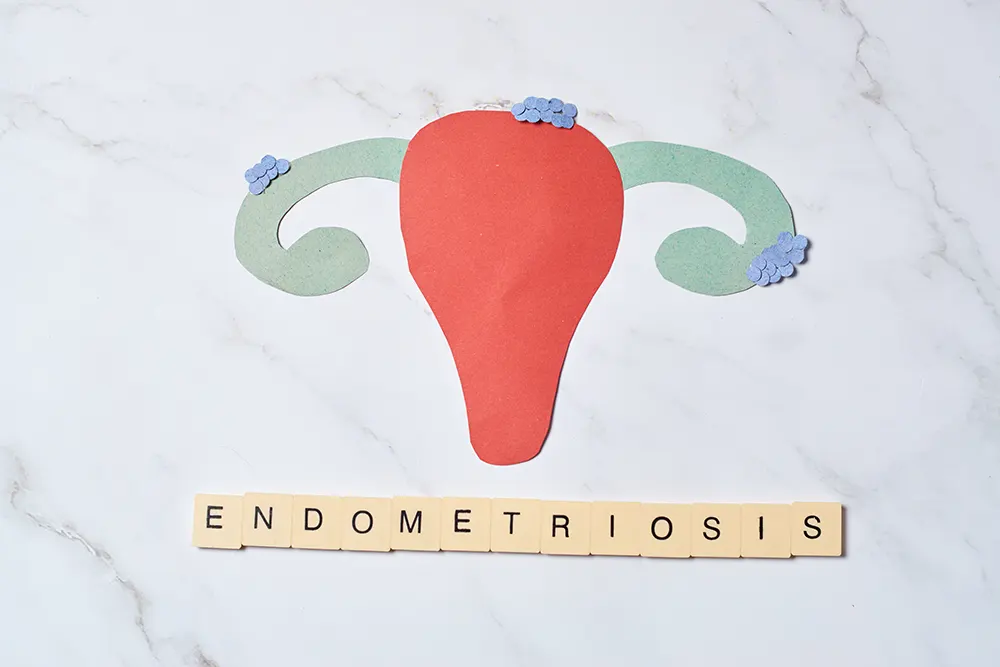Hysterectomy for Endometriosis: Is it the Right Choice for You?
I. Introduction
A. Explanation of the relationship between endometriosis and hysterectomy
Hysterectomy is the surgical removal of the uterus. Endometriosis is a chronic illness characterized by the abnormal growth of the uterine lining. Successful endometriosis treatment may involve hysterectomy. Pelvic pain, painful periods and infertility are just a few of the endometriosis symptoms that can significantly diminish an individual’s quality of life.
Endometriosis affects one out of ten women of childbearing age. It is a severe, protracted illness that can cause a great deal of suffering, including mental anguish, bodily discomfort, and tiredness. Yet, many individuals with endometriosis may have difficulty discovering suitable medications for symptom relief.

B. The need for individuals with endometriosis to consider the option of hysterectomy
Patients with endometriosis often reserve hysterectomy as a last choice, as it is a large operation with potentially severe long-term implications. Some women may find hysterectomy to be their best option for increasing their quality of life and reducing discomfort.
The purpose of this post is to inform endometriosis patients about considering hysterectomy as a treatment option. The association between endometriosis and hysterectomy, the numerous types of hysterectomies , and the advantages and disadvantages of this treatment will be discussed.
Due to the unique nature of each woman’s situation, the choice to undergo a hysterectomy should be taken after careful consideration with a healthcare practitioner, taking into account the woman’s personal needs, goals and preferences. The objective of this article is to offer readers knowledge useful for making decisions.
II. Understanding Endometriosis
A. Definition and symptoms of endometriosis
The condition known as endometriosis is characterized by the development of a tissue similar to the lining of the womb, outside of the uterus. This tissue can be found in the fallopian tubes, ovaries, and other pelvic organs. The bladder or intestine are two more pelvic structures to which the tissue may adhere.

The most common symptoms of endometriosis are painful periods and pelvic pain, particularly during menstruation. Heavy periods, pain during sex, exhaustion and infertility are further symptoms. Some women may not experience any symptoms at all, and the severity of the symptoms can vary.
B. Causes and risk factors of endometriosis
There are numerous possibilities, however, the specific etiology of endometriosis is still unknown. One idea holds that during menstruation, endometrial cells move via the fallopian tubes and into the pelvic cavity, where they attach and develop. According to a different hypothesis, endometrial cells are present at birth and begin to develop in the pelvic cavity.
Menstruating at a young age, having brief menstrual cycles, never giving birth and having a family history of endometriosis are risk factors for the disorder.
C. How endometriosis is diagnosed
Due to the symptoms’ resemblance to those of other illnesses including pelvic inflammatory disease or irritable bowel syndrome, endometriosis can be challenging to diagnose. Endometriosis is typically diagnosed through a laparoscopy, a surgical technique in which a thin, lit tube is placed through a tiny belly button incision to inspect the pelvic organs. The surgeon’s ability to observe endometrial tissue during the laparoscopy supports the diagnosis.
It’s vital to be aware that diagnosing endometriosis can be difficult, and that it may require numerous visits to a doctor before a diagnosis is determined. Surgery might be required in some circumstances to make a certain diagnosis. It’s also crucial to remember that not all women with endometriosis will exhibit the same signs and symptoms or feel the same degree of discomfort, and the disorder may exist without any visible symptoms. Therefore , it’s crucial that you communicate with your doctor and stand up for yourself during the diagnosis procedure if you think you might have endometriosis.
III. Hysterectomy as a Treatment for Endometriosis
A. How hysterectomy can help to alleviate symptoms of endometriosis
A hysterectomy is a surgical operation in which the uterus is removed. A hysterectomy can be a useful treatment option for endometriosis since it helps decrease symptoms such as pelvic pain and heavy periods. By eliminating the uterus , the pain-causing endometrial tissue is also eliminated.

B. Types of hysterectomies (ex: total hysterectomy, subtotal hysterectomy)
There are a variety of hysterectomies that can be performed on persons who have endometriosis. These include:
The total hysterectomy is the most common type of hysterectomy. During the surgery , the uterus and cervix are eliminated.
Subtotal hysterectomy: This treatment involves the removal of the uterus but leaves the cervix in place.
Radical hysterectomy: This kind of hysterectomy is carried out when malignancy is discovered or suspected. Removal of the uterus, cervix and all surrounding tissue.
Remember that selecting the type of hysterectomy to have should be done in consultation with a doctor and taking into account the individual’s specific needs, goals, and preferences
C. Risks and benefits of hysterectomy as a treatment for endometriosis
A hysterectomy is a big operation that carries with it some dangers. These dangers include hemorrhaging, infection, blood clots, and organ damage. In addition, hysterectomy is related to long-term concerns such as menopausal symptoms, osteoporosis and urine incontinence.
However, a hysterectomy can also offer considerable benefits for those with endometriosis. It can ease symptoms including pelvic discomfort and heavy periods and enhance the individual’s quality of life. Additionally, it can lower the likelihood of future issues such as ovarian cancer.
Before making a choice , it’s important to consider the advantages and potential risks of a hysterectomy. The fact that there are other therapies that can aid in symptom management and that hysterectomy is not the only option for treating endometriosis should also be kept in mind. If you want to thoroughly investigate all of your options and make an informed decision, working with a healthcare professional is essential.
IV. Alternative Treatments for Endometriosis
A. Overview of alternative treatments for endometriosis
Endometriosis sufferers have access to a variety of alternative therapies. These consist of:
Medication: By regulating the menstrual cycle and slowing the formation of endometrial tissue , hormonal medicines such as birth control tablets and gonadotropin-releasing hormone (GnRH) agonists can assist to relieve the symptoms of endometriosis.
Changes in lifestyle: Diet, exercise and stress reduction can all assist to lessen endometriosis symptoms.
Surgery: Endometrial tissue can be removed through minimally invasive procedures like laparoscopy to treat endometriosis symptoms.
B. Comparison of the effectiveness and side effects of alternative treatments
The effectiveness of alternative endometriosis therapies can vary from person to person. Surgery and hormone therapy can both be very helpful in reducing symptoms and improving a person’s quality of life. But they can also result in heat flashes, nausea and headaches.
Although lifestyle modifications can lessen endometriosis symptoms, they might not be as effective as medication or surgery. They might, however, also benefit your overall health and well-being.
It is critical to remember that every woman has a unique circumstance, and that the decision regarding therapy should only be made following a thorough discussion with a healthcare professional and taking into account the person’s particular needs, goals and preferences.
V. Deciding on Hysterectomy
A. Factors to consider when deciding on whether to undergo a hysterectomy for endometriosis
There are a number of things to take into account before having a hysterectomy for endometriosis. These comprise:
Severity of symptoms: A hysterectomy may be the best choice for people whose symptoms are severely impairing their quality of life.
Alternative therapies: If non-surgical therapies, such as medication or minimally invasive surgery, have failed to control symptoms , a hysterectomy may be required.
Future fertility plans: A hysterectomy will render the individual infertile. If the individual wishes to have children in the future, they should consider this before undergoing a hysterectomy.
Long-term implications: A hysterectomy is a major surgery and there are long-term implications to consider, such as menopause symptoms, osteoporosis and urinary incontinence.
B. How to prepare for a hysterectomy
If a hysterectomy is something you’re considering, there are a few things you can do to get ready. All of the following fall under this category:
Talking to a doctor is a must because there are many factors to consider before deciding on a hysterectomy , such as the type of hysterectomy, the risks involved and the length of time needed for recovery.
Physical exam and lab tests: A physical exam and lab tests may be necessary to ensure the individual is healthy enough for surgery.
Making arrangements: Arrangements should be made for transportation to and from the hospital, as well as for any necessary time off from work or other responsibilities. It’s also important to have someone available to help with tasks and provide support during recovery.
C. What to expect during recovery
The length of time it takes to feel back to normal after having a hysterectomy performed varies from patient to patient , although it usually takes several weeks. Carefully adhere to your doctor’s orders at this time, especially those pertaining to your activity level and wound care. The good news is that there are medications available to alleviate the widespread pain and discomfort.
Remember that if the ovaries are removed along with the uterus, menopausal symptoms like hot flashes may result after the hysterectomy. These symptoms may respond to hormone replacement therapy.
Whether or not to have a hysterectomy is a decision that should be taken in consultation with a healthcare expert after careful consideration of the patient’s unique circumstances, preferences, and goals. In addition, realizing that getting better might be tough but doable with the correct help is crucial.
VI. Conclusion
A. Summary of the information presented in the article
We’ve discussed the hysterectomy’s role in treating endometriosis, as well as its advantages and disadvantages , in this post. We’ve covered conventional treatments for endometriosis, like medication and dietary changes, as well as alternative methods, like surgery. We’ve also included information about how to plan for a hysterectomy, what to expect during recovery and what to consider before deciding to have one performed due to endometriosis.
B. Final tips on how to make an informed decision about hysterectomy as a treatment for endometriosis
When contemplating a hysterectomy as a kind of endometriosis treatment , it’s crucial to :
- Understand the procedure’s dangers and advantages.
- Examine all available alternative therapies
- Considering one’s own objectives and preferences
- Speak with a medical expert who has performed hysterectomies and is skilled in treating endometriosis.
C. Encouragement to seek professional advice and support
Choosing whether to have a hysterectomy can be a challenging and stressful process. It’s crucial to keep in mind that a hysterectomy is a big procedure and that getting professional guidance and assistance is crucial. A healthcare professional can help to ensure that a person is making the best option for them by offering advice and support throughout the decision-making process. It’s also crucial to keep in mind that there are resources and support groups accessible for those with endometriosis and those who have had hysterectomies , which can offer further support and knowledge.